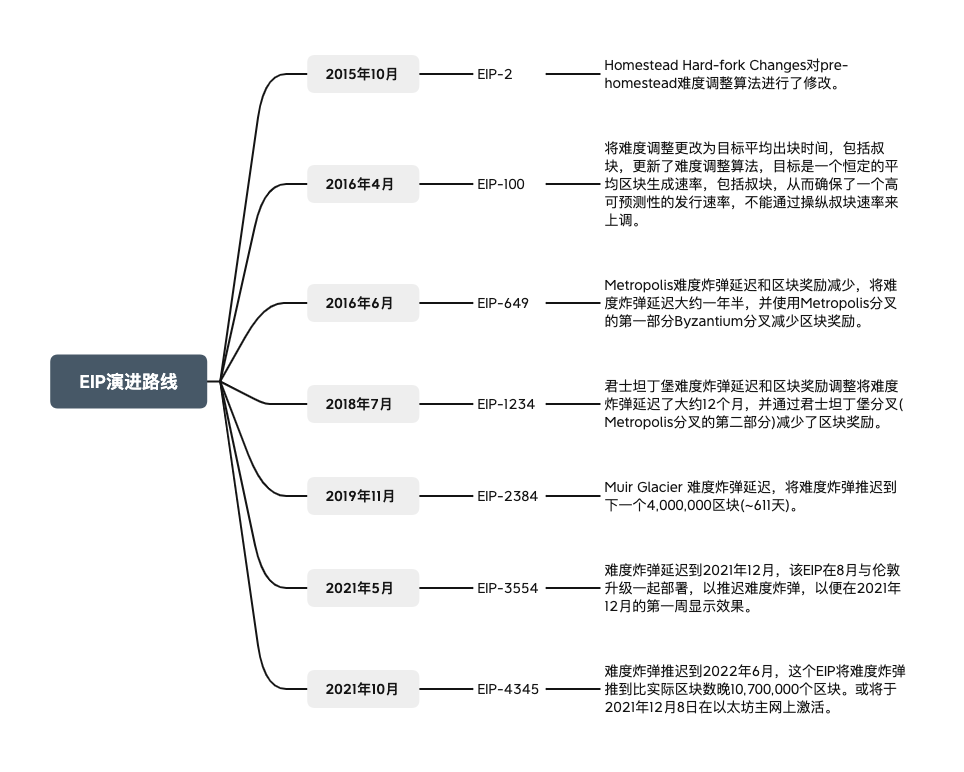The launch of the "Arrow Glacier Project" will bring these three benefits to Ethereum

According to the official Ethereum blog, the Arrow Glacier (Arrow Glacier) upgrade plan of Ethereum has delayed the difficulty bomb (Difficulty bomb), which is expected to be launched around December 8th at block 13,773,000. Exact dates may vary slightly due to block times and time zones. Looking back at the beginning of the year, Tim Beiko, the developer of Ethereum, once said that the difficulty bomb may occur in July, until October, and once again announced that it will be pushed to December.
So, why does Ethereum want to launch Arrow Glacier? What factors are restricting the delay of Arrow Glacier's launch time? Why is the difficulty bomb advancing so slowly? What are the benefits of the successful launch of Arrow Glacier? Odaily tries to clear up your confusion through this article.
What is the Arrow Glacier Project?
Ethereum Arrow Glacier (ArrowGlacier) is similar to the previous Muir Glacier upgrade, including only one EIP-4345 (EIP-4345 proposes to push the difficulty bomb back 10,700,000 blocks from the actual block height, which is later than the last time, that is, London The upgrade added 1,000,000 blocks), Arrow Glacier will also change the parameters of the Ethereum Ice Age difficulty bomb, delaying it by several months.
What is the difficulty bomb?
The difficulty bomb (Difficulty bomb) was coded in 2015. The purpose is to gradually increase the difficulty of blockchain mining and artificially slow down the issuance speed of Ethereum, so that Ethereum miners will eventually have nothing to mine and no profit. As a result, the PoW chain cannot run until it freezes. This mechanism is designed for the huge transformation of Ethereum from the proof-of-work (PoW) consensus algorithm to the proof-of-stake mechanism algorithm (PoS).
It’s worth noting that the difficulty bomb will only affect PoW networks, and thus only exist on the current PoW Ethereum mainnet and Ropsten testnet. With the transition of Ethereum to PoS, the Ethereum Foundation decided to postpone the difficulty bomb on the Ethereum mainnet for the time being, and try its best to make the difficulty bomb break out on the Ropsten testnet before the Ropsten testnet broke out and transition to PoS on the Ropsten testnet.
Looking back, Ethereum has gone through a long upgrade process since 2015. Why is it so slow?
Since the establishment of Ethereum, the huge sum of computing power is the biggest guarantee for its normal operation. Since the establishment of the ecology, Ethereum has continued to attract miners to join in through mining incentives to promote the growth of computing power. The ecology of mining is an economic model of hardware input and output. For example, the mining rewards of PoW miners are affected by many factors, such as policies, regions, power resources, mining equipment, etc., and the input costs are huge. PoS mining rewards are determined by the participants. The size of the pledged funds is determined. Therefore, if a forced change may cause PoW miners to abandon, the Ethereum community chooses to completely remove or delay the difficulty bomb through a hard fork.
 Therefore, how to persuade Ethereum ecological participants to transfer a large amount of resources to PoS ETH2.0 without a hard fork is an extremely difficult problem. In other words, the postponement of the difficulty bomb is not that Ethereum itself is not yet ready, but that ecological builders and participants need some time to cope with the upcoming huge changes and impacts.
Therefore, how to persuade Ethereum ecological participants to transfer a large amount of resources to PoS ETH2.0 without a hard fork is an extremely difficult problem. In other words, the postponement of the difficulty bomb is not that Ethereum itself is not yet ready, but that ecological builders and participants need some time to cope with the upcoming huge changes and impacts.
How does the launch of Arrow Glacier benefit the Ethereum ecosystem?
Although the process is difficult, the benefits of the transformation can be seen immediately. The launch of Arrow Glacier has promoted the key transformation of Ethereum from PoW to PoS, and will also bring many visible conveniences to the construction of the entire ecology and participants.
Increased block confirmation speed
Under the PoW mechanism, the block distribution is based on Poisson distribution (Poisson distribution), and the block generation time will vary greatly. The average block generation time is 13 seconds, but sometimes it exceeds 30 seconds or even 60 seconds. After sending a transaction, it takes an average of 13 seconds for the next block to appear. The PoS mechanism has a fixed block time, generating a block every 12 seconds, and the average waiting time for sending a transaction is 6 seconds. The only exception is when the proposer is offline, which is rare. After EIP-1559 is implemented on the main network, it will greatly improve the user experience of Ethereum.
security upgrade
As far as the finality of PoS is concerned, the block cannot be rolled back after it is confirmed for about two epochs (all data is sent to the network to complete a forward calculation and back propagation process). But before that, the speed of security improvement is much faster than PoW, because under the LMD GHOST fork selection rule, hundreds of proofs will be generated at the same time, which will form a model that is better than PoW (each block confirms Both require the consensus of the whole network) faster block generation speed. After 12 seconds, a block can be verified by hundreds of provers, making rollbacks very difficult.
In addition, in the PoW network, if half of the nodes are offline or cannot operate normally due to vulnerabilities and hacker attacks, it will take some time for other nodes in the network to find out. In contrast, in a PoS network, if the node participation rate of a single slot drops from 99% to a lower level, it is very easy to detect, and problems on the chain will be discovered immediately, which can ensure that dangers can be responded to and dealt with immediately. Get security.
The client is lighter
The PoW version of Ethereum has a light client, but the efficiency is far lower than the achievable function, and it is still a lot of time and resources to start and maintain. After absorbing the experience of PoW, the design of the PoS light client protocol is more sophisticated, and it only needs to download a few KB of data every day to keep in sync. This makes the browser built-in light client and mobile PoS light client wallet more feasible, greatly reducing the dependence on centralized service providers.



